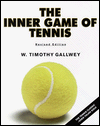« Best of JM: Top Picks |
Main
| Best of JM: Improvisation: Ensemble Hatching »
 May 26, 2011 | Best of JM: Inner Game of Tennis May 26, 2011 | Best of JM: Inner Game of Tennis
Enjoy the popular archive material below.
From January 16, 2007: "Inner Game of Tennis"
Physical Education intersects tremendously with the world of music pedagogy. The science of athletics can uncover commonalities between the pursuit of excellence in sports and learning to play a musical instrument. After all, both are about the effective connection of mind and body, and ultimately, the aesthetic and spiritual enjoyment of muscles and brain firing efficiently on all cylinders.
In the 70's, the book "The Inner Game of Tennis" by W. Timothy Gallwey (revised 1997) blazed trails in defining a whole new way of sports enthusiasts bettering their game, and it wasn't limited to tennis players. "Sports Psychology" was virtually virgin terrain in popular sports culture and education. Gallwey helped rewrite the handbook of effective personal sports training.
We recently read this book and couldn't help but glean important concepts in understanding mandolin playing and practice techniques. It's a simple notion that our brain short-circuits when we become overly analytical about the details of playing. Hold the wrist loose, don't grip the pick too hard, follow through in a rest-stroke from down-stroke to the next string down, watch the pick angle, keep the pinky from flying--all the particulars within these collective instructions can inhibit us in performing rather than helping if our "Inner Game" is not collected. It worsens exponentially in the pressures of tournament or public performance when we get hyper-critical and self-effacing.
The book goes into much detail, and we exhort you to read it. At over 7 million copies sold worldwide, your local public library probably has a copy, but you may wish to own one yourself. Meantime, we'll elaborate on three concepts we've gleaned.
- A valid instruction derived from another's experience can help me only if it guides me to my own experiential self-discovery. Instructions or tips from other players sand teachers will help, but only if your mind is able to translate into your experience. These should be guidelines, not commands. If you're told "grip the pick so it doesn't slip out of your hands," that still doesn't tell you how much pressure you ultimately exert. Since it WILL be different for each individual player, you need to take the nugget of suggestion and explore your own boundaries of pick pressure. It's about self-enlightenment, not someone pouring their answers into your own personal vat full of behavior.
- A child doesn't dig his way out of old grooves. He starts new ones. Our experience teaching dogs and children has always been more effective telling what TO DO more than what NOT to do. "Don't let the notes die in your fretting finger between string crossings." This is much more effectively expressed "Connect the last note from one string to the first note of the next string." It's a forward motion approach. Or saying "don't tense up," usually makes you even tenser; it's better to say "Relax!" We respond so much better than commands than barriers.
- Natural focus occurs when the mind is interested. Focus is not about thinking hard about something. Ever have a truly difficult passage you just couldn't concentrate on and play, even when you slowed down to snail speed? Maybe this passage is not tripping your synapses because you have nothing to hang it on. Your brain is not "interested." Take some moments for a little intellectual musical analysis. Is a chord arpeggio spelled out? A scale? What is the implied harmonic progression and is it more complex than the chords the rest of the ensemble is playing? Which are chord tones and which are passing notes? These are the questions that make your brain "dig;" ultimately what will make your fingers respond (and learn) after drilling.
There is much more you can learn from a Tennis Pro. Check out the rest of "The Inner Game of Tennis" for yourself!

Posted by Ted at May 26, 2011 6:20 AM

Disclaimer: In the 'Information Age' of the 21st Century,
any fool with a computer, a modem, and an idea can
become a self-professed 'expert." This site does not
come equipped with 'discernment.'
|



